|
 |
Juvenile Residential Facility Census, 2004: Selected Findings, Jan 2009
A report prepared by the National Center for Juvenile Justice, and published by the Office of Juvenile Justice and Delinquency Prevention (OJJDP), provides selected findings on facilities holding juvenile offenders and the range of services provided.This bulletin is part of the ongoing National Report series examining juvenile justice systems and practices in the United States. http://ojjdp.ncjrs.org/publications/PubResults.asp?sei=86 |
|
Adoration of the Question: Reflections on the Failure to Reduce Racial & Ethnic Disparities in the Juvenile Justice System
The W. Haywood Burns Institute (BI) has released the first of what will be a series of publications released in 2009 that explore the tools, insights and strategies that BI has used to help jurisdictions reduce disparities in their juvenile justice systems. Adoration of the Question: Reflections on the Failure to Reduce Racial & Ethnic Disparities in the Juvenile Justice System introduces the foundation of their approach by examining circumstances that continue to influence the juvenile justice system and outlining the early system's approach towards youth of color, DMC and its perceived causes. The publications goes on to analyze the well-intentioned federal mandates that have largely failed to reduce entrenched disparities in the system over the 20 years since Congress first mandated that states "address" DMC. For more information on the release of these publications, contact Shadi Rahimi at srahimi@burnsinstitute.org. |
|
New Report Highlights Reforms in Status Offender Systems
When Vera staff began working to reform status offender systems almost a decade ago, chronically misbehaving youth were routinely referred to juvenile court and subject to the same punitive interventions as youth charged with criminal activity. Experience has shown that such interventions are costly and often exacerbate existing family challenges. Today, as jurisdictions evaluate and refine their status offender systems, a new paradigm is emerging that aims to provide immediate, individualized services to youth and their families outside of the juvenile court system. Making Court the Last Resort: A New Focus for Supporting Families in Crisis [pdf], a new report from Vera’s Center on Youth Justice, describes this new paradigm by highlighting successful status offender system reforms in Florida, New York, and Connecticut. http://www.vera.org
OJJDP Bulletin Portrays Domestic Assaults by Juveniles
The Office of Juvenile Justice and Delinquency Prevention (OJJDP) has published "Domestic Assaults by Juvenile Offenders." Prepared by the National Center for Juvenile Justice, this 8-page bulletin analyzes data reported to the FBI's National Incident-Based Reporting System by law enforcement agencies. The bulletin provides a detailed portrait of the attributes of domestic assaults by juveniles known to law enforcement, including their locations, times of day, and the weapons involved. "Domestic Assaults by Juvenile Offenders" is available online at
http://ojjdp.ncjrs.gov/publications/PubAbstract.asp?pubi=240971.
JPI report reveals harmful impact of federal juvenile sex offender law
The Justice Policy Institute announces the publication of our newest report, Registering Harm: How sex offense registries fail youth and communities. During the next year, states throughout the country will determine whether to comply with the Adam Walsh Act, the federal law that requires mandatory public registration for youth over the age of fourteen who are convicted of certain sex offenses. Congress passed this law in an attempt to protect our children from sexual violence. But, as documented in this new report, the Adam Walsh Act won't keep our children safe. Instead this law will needlessly target children and families, undermine the very purpose of the juvenile justice system, and consume law enforcement resources. Thankfully, states can opt out of compliance with this law and make smart investments in programs and policies that will actually protect our children and our communities. Click here to learn more about the Adam Walsh Act and to access JPI's newest report. To access the accompanying briefing book on this topic, click here http://www.justicepolicy.org/
Guidebook for Juv Justice & Child Welfare System Coord & Integration
The CWLA has announced the availability of the Guidebook for Juvenile Justice and Child Welfare System Coordination and Integration: Framework for Improved Outcomes (by Janet K. Wiig, with John A. Tuell, 2004; revised, 2008). Built from years of collaborative expertise and experience, the newly revised 2008 Guidebook continues to use a comprehensive framework to guide state and local jurisdictions in achieving greater system coordination and integration for children, youth and families that populate multiple youth serving systems. The Guidebook utilizes current research, best practice, and highlights numerous examples from jurisdictions across the country that have worked diligently to develop new practices, policies, procedures and protocols that will serve to improve the outcomes for multi-system children, youth and their families.
View online a PDF version of the Guidebook for Juvenile Justice and Child Welfare System Coordination and Integration: Framework for Improved Outcomes
http://www.cwla.org/programs/juvenilejustice/jjguidebook08.pdf
View online a PDF version of the Child Welfare & Juvenile Justice Systems Integration Initiative: A Promising Progress Report.
http://www.cwla.org/programs/juvenilejustice/jjprogressreport.pdf
Recent study finds that abused and neglected youth who are placed in group homes are two-and-a-half times more likely to be arrested.
Juvenile Delinquency in Child Welfare: Investigating Group Home Effects
By Joseph P. Ryan, Jane Marie Marshall, Denise Herz, and Pedro M. Hernandez.
www.cwla.org/programs/juvenilejustice/grouphomeeffects.pdf
MacArthur Newsletter New Study Finds Time Spent Online
Important for Teen Development
11-2008 Read here
http://www.macfound.org/site/c.lkLXJ8MQKrH/b.4773437/k.3CE6/
New_Study_Shows_Time_Spent_Online_
Important_for_Teen_Development.htm
|
|
Juvenile Arrest Data for 2006
This report summarizes 2006 juvenile crime and arrest data reported by local law enforcement agencies across the country and cited in the FBI report, Crime in the United States 2006. This information is used to characterize the extent and nature of juvenile crime that comes to the attention of the justice system.
www.ojjdp.ncjrs.gov/publications/PubAbstract.asp?pubi=243205 or
www.fbi.gov/ucr/cius2006/index.html
|
|
Using Adolescent Brain Research to Inform Policy:
A Guide for Juvenile Justice Advocates
NJJN Policy Brief reviews the current research on adolescent brain development and its effect on young people's behavior, and discusses how to respectfully frame the research in consideration of our youth allies. The brief also discusses how the research relates to positive youth development, how it may be applied in other contexts, and how it relates to disproportionate minority contact.
http://njjn.org/media/resources/public/resource_847.pdf
|
|
Campaign for Youth Justice Releases Report on Racial Inequalities Facing
Black Youth in the Juvenile and Adult Crim Justice Systems
In "Critical Condition: African American Youth in the Justice System," the Campaign for Youth Justice, an NJJN partner, sheds light on the lack of progress in reducing the vast disparities in treatment between African-American and white youth over the past 20 years. The report highlights the fact that black youth continue to be overrepresented at most stages in the justice system. Data show that African American youth receive harsher treatment than whites from arrest through prosecution. Additionally, the overwhelming majority (83%) of cases that were filed in adult courts involved youth of color.
http://njjn.org/media/resources/public/resource_852.pdf
|
|
UNDERSTANDING THE SECOND CHANCE ACT
The Council of State Governments Justice Center offers as a resource to potential Second Chance Act grantees a four-page fact sheet on the State and Local Reentry Demonstration Project grants that were authorized by Section 101 of the Second Chance Act. This document draws upon the language in the statute to direct potential applicants to important elements that require advance planning.
http://www.magnetmail.net/images/clients/ICCA/attach/SCA_Facts.doc
|
|
|
|
Calf Governor Signs Family Communication and Youth Rehabilitation ActOn September 28, Governor Arnold Schwarzenegger signed California's Family Communication and Youth Rehabilitation Act (S.B. 1250), which is expected to reduce recidivism by allowing for greater family communication. The Act ensures parents and guardians are notified in cases of emergency; provides for notification to families of upcoming parole hearings; allows youth to speak on the phone with family, clergy or legal counsel in their native language; requires youth facilities to provide blank paper, envelopes and pencils to youth in a manner consistent with institutional safety; allows youth to write letters to family, clergy or counsel in their native language; and provides youth with a written description of rights while in custody. Click "Read more" to read the Act.http://njjn.org/resource_870.html
|
|
UNDERAGE ALCOHOL USE
In 2006, more than one in four persons aged 12 to 20 in the United States, or about 10.8 million persons, drank alcohol in the past month (i.e., were current drinkers). Each year approximately 1,900 people under the age of 21 die as a result of alcohol-involved motor vehicle crashes. In addition, early initiation of alcohol use is associated with increased likelihood of unprotected sexual intercourse and multiple sex partners. A majority (53.4 percent) of current alcohol users aged 12 to 20 drank at someone else's home the last time they used alcohol, and another 30.3 percent drank in their own home. The percentage of underage alcohol users who had their most recent drink in a car or other vehicle peaked at 10.0 percent at age 16 (12.8 percent of females and 7.3 percent of males). Among 20-year-old current drinkers, 20.0 percent of females drank in a restaurant, bar, or club the last time they used alcohol compared with 10.2 percent of males. Read here.
|
|
REDUCING RACIAL DISPARITY
The Sentencing Project has just published a new edition of "Reducing Racial Disparity in the Criminal Justice System," a comprehensive manual for practitioners and policymakers. The publication provides insight into how racial disparities develop in the criminal justice system, and workable solutions to address and reduce disparities. The manual provides strategies for addressing disparities at each stage of the system, as well as 17 "best practices" illustrating practitioner approaches for enhancing fairness. "Reducing Racial Disparity in the Criminal Justice System" is a tool for criminal justice practitioners, policymakers, and community organizations seeking to develop constructive approaches to one of the most challenging problems facing the criminal justice system. Read here.
|
|
REENTRY FOR SAFER COMMUNITIES
The National Association of Counties (NACo)'S new publication titled Reentry for Safer Communities focuses on effective county practices in jail-to-community transition planning for offenders with both mental health and substance abuse disorders. NACo convened a Reentry Focus Group of experts from the health and criminal justice fields to identify possible model sites around the country and discuss the necessary elements of a successful reentry program. The criteria used to determine model sites include level of collaboration among agencies, access to benefits, sustainability of the program, cultural/gender components and community linkages of support. The model sites are Allegheny County, Pennsylvania; Auglaize County, Ohio; Black Hawk County, Iowa; Macomb County, Michigan; Montgomery County, Maryland; and Multnomah County, Oregon. Read here
|
|
PATHWAYS TO GOOD JOBS FOR HIGH SCHOOL DROPOUTS
This paper (30 pages) advocates expansion and better integration of efforts to connect high school dropouts between the ages of 16 and 24 to pathways to postsecondary credentials that have value in the labor market. The paper highlights examples of innovations in policy, program delivery, pedagogy in adult education, youth development and dropout recovery, and postsecondary education that should be built upon in developing more robust and successful dropout recovery and postsecondary education policies and practices to open the door to higher wages and career opportunities for this population. The authors urge federal officials, governors, school administrators, college officials, workforce leaders and employers to provide leadership in building the supports and pathways at scale to bring dropout youth back into the education and labor market mainstream.
|
|
REPORT ON YOUTH COURTS AND TEEN COURTS
Global Issues Resource Center has published the 1st Report to the Nation on Youth Courts and Teen Courts (43 pages) documenting significant highlights and events over a fifteen year period of unprecedented and historic growth of this groundbreaking American juvenile justice prevention and intervention program that utilizes volunteer youth to help sentence their peers. The report begins in 1993, when fewer than seventy-five local youth and teen courts existed in just about a dozen states. The report concludes fifteen years later in 2008, when more than a record 1,000 local communities in 48 states and the District of Columbia now operate these local juvenile justice programs. Historic numbers of youth and adults are now involved, as more than 111,868 juvenile cases were referred to local youth and teen courts and more than 133,832 volunteers – to include both youth and adults who volunteered to help with the disposition and sentencing of these juvenile cases.
http://www.magnetmail.net/images/clients/ICCA/
attach/15_Year_Report_on_Youth_Courts.doc
|
|
MODEL POLICIES JUVENILE SUBSTANCE ABUSE TREATMENT
On October 10, 2008, a national task force released a new report titled "Model Policies for Juvenile Justice and Substance Abuse Treatment," which sets forth recommendations drawn on lessons learned from the Robert Wood Johnson Foundation's Reclaiming Futures initiative and includes measures to improve policies at the federal, state, and local levels. The policy recommendations at the federal level included repealing regulations that prevent funding for substance abuse treatment, mandating Medicaid coverage for youth in public institutions, and changing the Juvenile Justice and Delinquency Prevention Act (JJPDA) to specifically include and define substance abuse treatment services. Recommendations for policy changes at the state level included requiring multi-agency collaborations in state contracts and grants and integrating cross-agency program funding. Local governments were encouraged to utilize a memorandum of understanding (MOU) across all youth-serving community institutions to support re-entry from the juvenile justice system through linkage with community services, education, employment services, and other community programs.
|
|
CHILDHOOD IQ POSSIBLY LINKED TO ADULT ALCOHOL USE
Contrary to expectations, higher intelligence scores at age 10 may be associated with higher levels of alcohol intake and alcohol-related drinking problems during adulthood, study findings suggest. Moreover, these associations appear "markedly stronger among women than among men," Dr. G. David Batty, from the University of Glasgow in Scotland, and colleagues report in the American Journal of Public Health. Batty's team assessed associations between mental ability scores obtained when 8170 boys and girls were 10 years old and their alcohol intake and alcohol problems when they were about 30 years old. Of the 3895 men and 4148 women who reported drinking alcohol as adults, those with higher average scores on childhood mental ability tests were also more likely to have indications of alcohol problems in adulthood. Read here
|
|
SPECIAL JOURNAL ISSUE - The Future of Children
The Brookings Institution and Princeton University have published Juvenile Justice, which represents the Fall 2008 issue of The Future of Children, a journal devoted to issues relating to America's youth. Found in this issue are the following articles: "Adolescent Development and the Regulation of Youth Crime," "Improving Professional Judgments of Risk and Amenability in Juvenile Justice," "Disproportionate Minority Contact," "Juvenile Crime and Criminal Justice: Resolving Border Disputes," "Understanding the Female Offender," "Adolescent Offenders with Mental Disorders," "Juvenile Justice and Substance Use," and "Prevention and Intervention Programs for Juvenile Offenders," http://www.futureofchildren.org/usr_doc/Justice_08_02.pdf.
|
|
MENTAL HEALTH AMONG YOUTH
Mental health services for children and youths are provided in a variety of settings, including specialty mental health service settings, such as community mental health centers, as well as nonspecialty settings, such as schools and general medical practice settings. For youths, nonspecialty settings, particularly schools, may be especially important in accessing mental health services. As a result, many leading youth mental health service delivery models call for the coordination of care provided in specialty and nonspecialty settings, and adopting a "no wrong door" approach to accessing mental health services. A new report examines data on youth mental health service utilization from the 2005 and 2006 National Surveys on Drug Use and Health (NSDUH), applying the categories for specialty and nonspecialty settings commonly used in the youth mental health services literature. Read here
|
|
EDUCATION TOOLKIT FOR AT-RISK YOUTH
A new toolkit is available to help improve the educational services provided to youth in the juvenile justice system. "Transition Toolkit 2.0: Meeting the Educational Needs of Youth Exposed to the Juvenile Justice System" was developed by the National Evaluation and Technical Assistance Center for the Education of Children and Youth Who are Neglected, Delinquent or At-Risk (NDTAC). The toolkit provides practical and empirical information such as sample forms, protocols, and tools currently used at each stage of the justice system, with a focus on effective records transfer and maintenance and increased family involvement. The Toolkit also contains a self-study and planning tool to guide program improvement within facilities for youth who are delinquent. Go to: http://www.neglected-delinquent.org.
|
|
PASSPORT TO ADULTHOOD
The Center for Court Innovations has created a unique tool to help judges ensure that the complex issues faced by youth in foster care are addressed in a timely and thorough manner. The Passport to Adulthood, which was piloted by New York City Family Court, is designed to help point courts in the right direction as teens age out of foster care. Thanks to the U.S. Department of Justice's Office of Juvenile Justice and Delinquency Prevention, they are offering technical assistance to courts around the country that are interested in adapting this tool. For more information, please contact vanstraj@courtinnovation.org.
|
|
MONITORING SEX OFFENDERS
APPA and ICPA offer a new publication, Strategically Monitoring Sex Offenders: Accessing Community Corrections' Resources to Enhance Law Enforcement Capabilities.
|
|
RELEASE PLANNING GUIDE
The Justice Center at the Urban Institute has publish "Release Planning for Successful Reentry: A Guide for Corrections, Service Providers, and Community Groups." The 104 page guide is the result of a 43-state research survey funded by the Annie E. Casey Foundation.
|
|
JUVENILE JUSTICE BLOG
The U.S. Department of Justice's National Institute of Corrections has established a blog to facilitate the exchange of information among juvenile justice professionals. Juvenile Justice Connection will feature news from NIC, the Office of Juvenile Justice and Delinquency Prevention, and other Federal, state, and local sources, including information about professional training opportunities and juvenile justice-related research. The blog also offers RSS feeds.
http://community.nicic.org/blogs/juvenilejustice/default.aspx.
|
|
Best Practices To Address Community Gang Prob
OJJDP's National Youth Gang Symposium, held June 24–26, in Atlanta, GA, featured the theme “Partnering to Prevent Gang Violence: From Faith-Based and Community Organizations to Law Enforcement.” OJJDP Administrator J. Robert Flores addressed the symposium, as did Nicky Cruz, a former gang leader working to help troubled youth. The new report “Best Practices To Address Community Gang Problems: OJJDP's Comprehensive Gang Model” was released at the symposium The report guides communities responding to a gang problem in implementing OJJDP's Comprehensive Gang Model. It describes best practices learned from practitioners experienced in planning and implementing the model and notes findings from evaluations of programs demonstrating the model.
Print copies may be ordered at www.ncjrs.gov/app/publications/
|
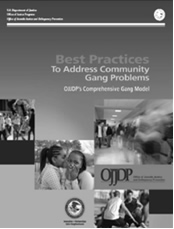 |
Violence by Teenage Girls: Trends and Context
Bulletin: Girls Study Group Series, May 2008. Examines the involvement of girls in violent activity (including whether such activity has increased relative to the increase for boys) and the contexts in which girls engage in violent behavior. Available online only. 24 pages. NCJ 218905. Zahn, M.A., Brumbaugh, S., Steffensmeier, D., Feld, B.C., Morash, M., Chesney-Lind, M., Miller, J., Payne, A.A., Gottfredson, D.C., Kruttschnitt, C.Examines the involvement of girls in violent activity (including whether such activity has increased relative to the increase for boys) and the contexts in which girls engage in violent behavior. Increasing arrest rates of girls led the Office of Juvenile Justice and Delinquency Prevention (OJJDP) to convene the Girls Study Group. The Girls Study Group examines strategies to reduce girls’ involvement in violence and delinquency. This OJJDP Bulletin assesses trends of juvenile arrest rates for violent crimes, focusing on simple and aggravated assault.
|
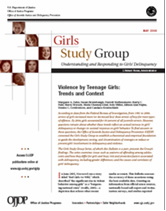 |
Impending Crime Wave Report Questioned
In “Getting the Facts Straight” the National Council on Crime and Delinquency (NCCD) reviews the Third Way report, “The Impending Crime Wave,” released in February of 2008. Third Way’s report describes the convergence of four new and menacing sociological trends, which are said to threaten a new and devastating wave of crime in America. The paper offers more than 100 specific, federal, state and local policy options that can be tailored to create a 21st century crime-fighting agenda. NCCD’s report identifies troubling flaws with Third Way’s arguments and the data used to support them. NCCD also finds that the described “trends” are based on incorrect data, that the report fails to identify the precise age group it refers to throughout its arguments and that the tone of the report’s title and language is a deliberate attempt to foster fear through the use of false statements. Read a copy of the Third Way report and NCCD’s response here: www.vjja.org/resources.html, or visit the individual websites here: www.thirdway.org/issues/show/32 and www.njjn.org/issue_181.html.
|
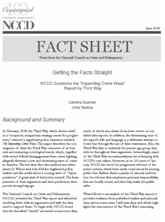 |
Effect of Advocacy on Youth in Care after Age 18
Strong advocacy within the juvenile court on behalf of foster youth plays a primary role in keeping youth in care after age 18, according to a new Chapin Hall study. The study examines foster youth in Illinois, one of the few states that extends care up to age 21.
Researchers found that a higher degree of court advocacy is associated with a greater availability of placements and services for older foster youth, more involvement by caseworkers and other adults, more positive attitudes about remaining in care beyond 18, and a greater awareness that, by law, youth may remain in care beyond 18.
Read the issue brief, Continuing in Foster Care Beyond Age 18: How Courts Can Help, by Clark Peters, Katie S. Claussen Bell, Andrew Zinn, Robert M. Goerge, Mark E. Courtney.
|
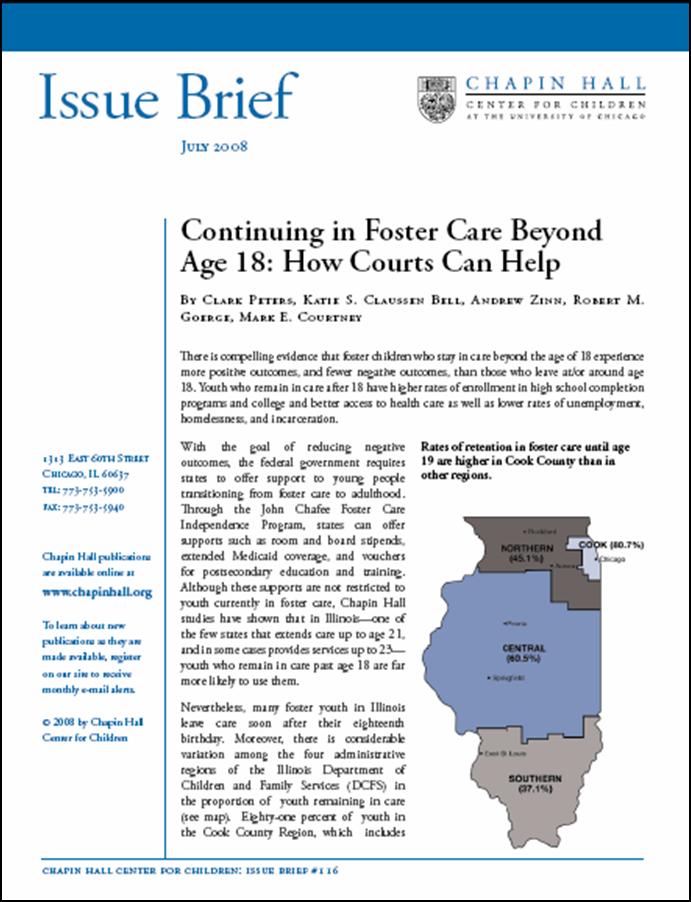 |
Incorporating Positive Youth Development in Juv Justice Programs
A new report explores six juvenile justice programs that use positive youth-development principles to improve their intervention approaches. The study describes the factors that facilitate the adoption of such principles as well as implementation challenges.
Read the report, Building on Strength: Positive Youth Development in Juvenile Justice Programs, by William H. Barton and Jeffrey A. Butts.
|
|
What Is Juvienation?
Juvienation is written and published by Mark Sorkin, a journalist living in Brooklyn, New York. It is a news site covering developments in juvenile justice, a forum for exploring ideas on how to reform the system, and a resource for anyone interested in or curious about the subject. Along with regularly updated blog posts, Juvienation is also a repository of links to relevant articles, policy papers, websites and books. To join in the discussion visit: http://juvienation.wordpress.com
|
|
America’s Cradle to Prison Pipeline
The Children’s Defense Fund has issued a new report, America’s Cradle to Prison Pipeline, documenting an urgent national crisis at the intersection of poverty and race that puts Black boys at a one in three lifetime risk of going to jail, and Latino boys at a one in six lifetime risk of the same fate. The report was released at a national Cradle to Prison Pipeline® Summit at Howard University in Washington, DC that addressed the nationwide crisis and its devastating impact on children, youth and their families, particularly within the Black and Latino communities. Download the full report at:
www.childrensdefense.org.
|
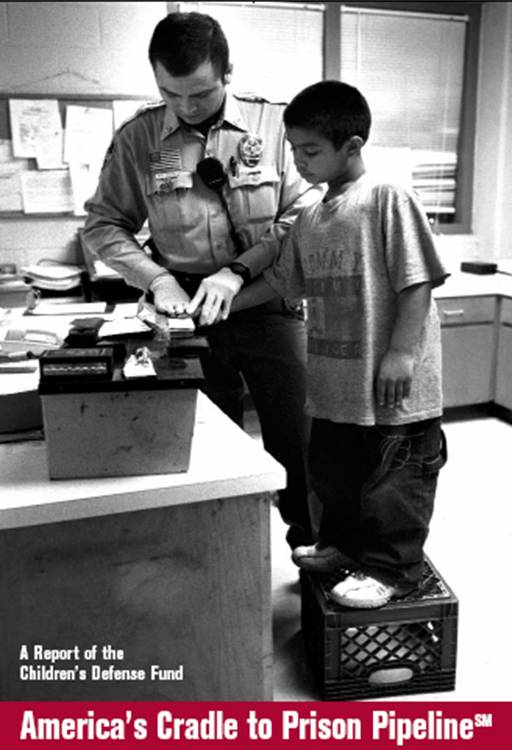 |
VADJJ FY 2007 Data Resource
Guide Released
Virginia Department of Juvenile Justice
The Virginia Department of Juvenile Justice has released the 2007 Data Resource Guide. First published in FY 2001, the guide has become a key source of information for those who work with system-involved children in the Commonwealth. The document provides descriptions of key programs and functions within the VADJJ, as well as demographic information and other data on court-involved young people. The information can be used to assess needs for the Commonwealth as a whole, as well as specific localities. The guide can be viewed or downloaded from the resources section of the Department of Juvenile Justice's website at: www.djj.virginia.gov/.
|
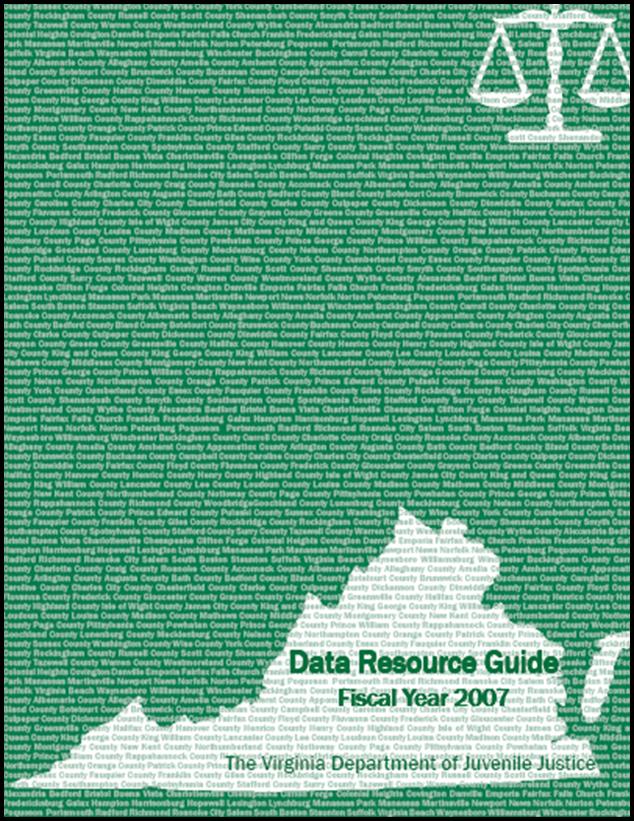 |
Motivating Offenders to Change:
Guide for Probation and Parole
National Institute of Corrections
This publication "provides probation and parole officers and other correctional professionals with both a solid grounding in the principles behind MI [motivational interviewing] and a practical guide for applying these principles in their everyday dealings with offenders" (p.2). Seven chapters are contained in this guide: how MI fits in with evidence-based practice; how and why people change; the motivational interviewing style; preparing for change; building motivation for change; navigating through tough times--working with deception, violations, and sanctions; and from start to finish--putting MI into practice. The publication can be viewed or downloaded from the resources section of the VJJA website or by visiting: http://nicic.org/library/022253/
|
|
Jailing Juveniles: The Dangers of Incarcerating Youth in Adult Jails in America
Campaign for Youth Justice
A new report released by the Campaign for Youth Justice provides a summary of the risks that youth face when incarcerated in adult jails, facts and figures about how many youth are incarcerated in jails nationwide, and a review of the limited federal and state laws protecting youth in jails. The publication can be viewed or downloaded from the resources section of the VJJA website or by visiting www.campaignforyouthjustice.org |
|
Juvenile Delinquency Guidelines: Improving Court Practice in Juvenile Delinquency Cases
National Council of Juvenile & Family Court Judges
This publication is a benchbook of best practices developed by a committee of judges & other key professionals representing stakeholders in juvenile justice. The publication can be viewed or downloaded from the resources section of the VJJA website or by visiting the website of the National Council of Juvenile & Family Court Judges website at : www.ncjfcj.org/
|
|
Evidence-Based Practice to Reduce Recidivism: Implications for State Judiciaries
The reduction of recidivism by state judiciaries utilizing six principles of evidence-based practice (EBP) is explained. Seven sections follow an executive summary: introduction; current state sentencing policies and their consequences; drug courts -- the state judiciary's successful experiment with EBP; the principles of EBP; local sentencing and corrections policy reforms; state sentencing and corrections policy reforms; and conclusion. "[C]arefully targeted rehabilitation and treatment programs can reduce offender recidivism by conservative estimates of 10-20%" The publication can be viewed or downloaded from the resources section of the VJJA website or by visiting http://nicic.org/Library/022843
|
|
Gang Wars: The Failure of Enforcement Tactics & the Need for Effective Public Safety Strategies
Justice Policy Institute
report seeks to debunk pervasive myths about gang crime. “More police, more prison and more punishment have not stopped gang violence” The publication can be viewed or downloaded from the resources section of the VJJA website or by visiting www.justicepolicy.org
|
|
Tools of the Trade: A Guide to Incorporating Science Into Practice
National Institute of Corrections
Faye S. Taxman, et. al
The application of evidence-based research findings to the practice of offender supervision is explained. Sections of this manual include: introduction -- supervision as a behavioral management process to reduce recidivism; behavior and change; assessment and planning; communication tools; information tools; incentives to shape offender behavior; service tools; offender types; and guiding principles.The publication can be viewed or downloaded from the resources section of the VJJA website or by visiting: www.nicic.org/Library/020095 |
|
Beyond Detention
Annie E Casey Foundation
Book #14 in the Juvenile Detention Alternatives Initiative Pathways series on juvenile detention reform. It documents the ways in which detention reforms in general – and JDAI’s comprehensive reform model in particular -- stimulate and support other juvenile justice system improvements. The publication can be viewed or downloaded from the resources section of the VJJA website or by visiting www.aecf.org |
|
The Consequences Aren't Minor: The Impact of Trying Youth as Adults and Strategies for Reform.
Campaign for Youth Justice
This study examines the laws and data in seven key states: California, Connecticut, Florida, Illinois, North Carolina, Virginia, andWisconsin. An estimated 200,000 youth end up in the adult system each year, and 40 states allow or require the jailing of these youth in adult facilities before they ever go to trial. The publication can be viewed or downloaded from the resources section of the VJJA website or at www.campaignforyouthjustice.org |
|
Kids Are Different
John D. and Catherine T. MacArthur Foundation
The John D. and Catherine T. MacArthur Foundation funded the development of Understanding Adolescents: A Juvenile Court Training Curriculum, training materials for juvenile justice professionals, as a joint project of the Youth Law Center, Juvenile Law Center, and the American Bar Association Juvenile Justice Center. The result was a training curriculum that applies the findings of adolescent development and relates research to practice issues confronted by juvenile court practitioners at the various decision-making stages of the juvenile justice process. This set of publications can be viewed or downloaded from the resources section of the VJJA website or by visiting www.nccd-crc.org |
|
And Justice For Some: Differential Treatment of Youth of Color
National Council on Crime & Delinquency
This report details the accumulated disadvantage for youth of color as they move through the juvenile justice system and, too often, into the adult system. This publication can be viewed or downloaded from the resources section of the VJJA website or by visiting http://www.njdc.info/ |
|
Juvenile Offenders and Victims:
2006 National Report
Office of Juvenile Justice and Delinquency Prevention
This report cites FBI and other reliable research to provide a comprehensive and insightful view of the nature of juvenile crime and violence across the nation. This report offers the Congress, State legislators, local policymakers, professors, juvenile justice professionals, and concerned citizens solid answers to the most frequently asked questions about the nature of juvenile crime and victimization and about the justice system's response. This publication can be viewed or downloaded from the resources section of the VJJA website or by visiting http://ojjdp.ncjrs.org/
|
|
2007 KIDS COUNT Data Book: State Profiles of Child Well-Being
Annie E. Casey Foundation
This 18th annual KIDS COUNT Data Book provides national and state-by-state information and statistical trends on the conditions of America’s children and families. This year’s essay examines the child welfare system and challenges the country to make lifelong connections for children and youth in foster care a national priority. This publication can be viewed or downloaded from the resources section of the VJJA website or by visiting www.aecf.org
|
|
Justice by Gender: The Lack of Appropriate Prevention, Diversion & Treatment Alternatives for Girls in the Juv Just System
Jointly issued by the American Bar Association and the National Bar Association
Over the last two decades we have witnessed a marked increase in the number of girls touched by, and and involved in, the juvenile justice system; yet this system seems singularly ill prepared to handle those cases. This publication can be viewed or downloaded from the resources section of the VJJA website or by visiting www.abanet.org
|
|
Juvenile Female Offenders: How Do You Meet Their Needs in Your Juvenile Justice Setting?
Office of Juvenile Justice & Delinquency Prevention &
National Institute of Corrections
Report presented at the 2006 National Juvenile Correctional and Detention Administrators Forum, Pittsburgh, PA. Topics covered include: introduction to the NIC and OJJDP collaboration; current perspective, research into juvenile female offender practice; current research -- a look at the work of OJJDPs Girls Study Group; and NICs approach to address the issue. The publication can be viewed or downloaded from the resources section of the VJJA website or by visiting http://www.nicic.org/Library/021453
|
|
|

